France with kids: A different kind of adventure beyond Paris
The French countryside is more family-friendly than you’d imagine. Think castles without crowds, hands-on history and a theme park powered by imagination. Here are nine unforgettable stops, from the Loire Valley to Normandy.

Mont Saint Michel in twilight. (Photo: Adobe Stock)

This audio is generated by an AI tool.
Having family in Brittany has long shaped how we see France – not just as a destination, but as a place where childhood unfolds with space, curiosity and slower rhythms. This summer, with two children in tow and a car packed with snacks, we set off on a road trip through western France.
We weren’t racing through landmarks. Instead, we were looking for tower-dotted valleys, medieval villages and storybook towns. Planning a trip like this isn’t always straightforward. Some of the most rewarding stops still rely on physical brochures and French-only websites. For international families (especially those coming from Asia), planning a trip like this can feel surprisingly difficult to navigate. That challenge is exactly what inspired me to write this.
For those used to the Paris–London or Paris–Nice circuits, this stretch of western France will feel refreshingly built for families: Easy-to-navigate roads, cleaner towns and ample space to roam. It’s not a classic tourist route but it’s the one we mapped for our family, and it might just work for yours too.
This 10-to-14-day road trip through western France starts in Guedelon, with its medieval castle-in-the-making, and moves into the Loire region with stops Amboise, Saumur and Louresse-Rochemenier, where history and tradition are vividly preserved. In Les Epesses and Nantes, imagination takes flight at Puy du Fou and Machines de l’lle respectively. Wildlife awaits in Port-Saint-Pere’s Planete Sauvage, before the journey crescendos at Mont-Saint-Michel and ends serenely in Giverny, in Monet’s garden.
GUEDELON: THE CASTLE WHERE TIME IS FORGOTTEN
Two and a half hours from Charles de Gaulle Airport, Guedelon Castle isn’t a typical first stop. It’s a castle in progress, built entirely using only the tools and materials of the Middle Ages.
Since 1997, a team of 40 master builders, including stonemasons, carpenters, blacksmiths, potters, have been constructing this medieval fortress from scratch. No power tools, no machinery, just hand-forged iron, rope pulleys and the strength of oxen.
Everything is made on-site, from the wooden beams down to the bread and rope. The surrounding forest provides timber. Stone is quarried nearby. The gardens are planted with crops appropriate to the period. Even the sourdough uses organic flour milled from ancient grains. No interactive screens here; it’s part-archaeological experiment, part open-air theatre.
Visitors can try their hand at stone carving, rope weaving or tile making. A couple of hours here is enough to get lost in another century, leave with a new respect for craft, patience… and a bit of dust on your shoes.
AMBOISE: DA VINCI’S FINAL CHAPTER
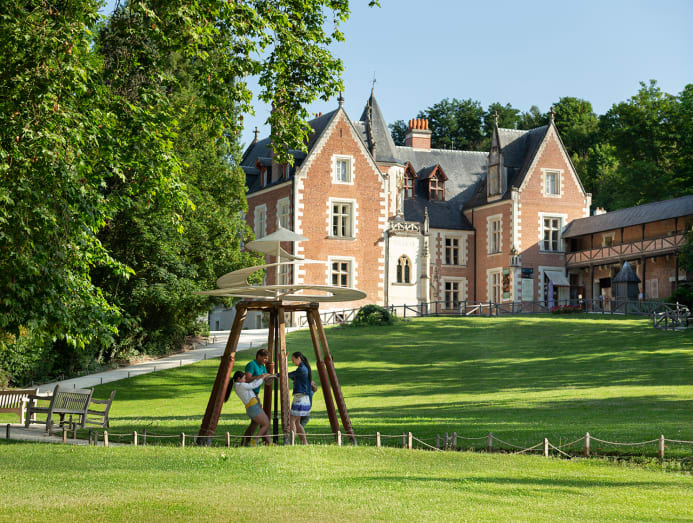
Amboise is a beautiful town that feels lifted from the pages of a fairytale: Renaissance stone houses, a clock tower, festive flags, and overlooking it all, the elegant Chateau d’Amboise, once a royal residence.
A few minutes away lies Chateau du Clos Luce, the final home of Leonardo da Vinci. Today, it’s a window into his world. Bridges designed by da Vinci appear throughout the gardens, and 20 of his life-size inventions ̶ an aerial screw, tank, fan-shaped machine gun, squirrel wheel ̶ are scattered across the park waiting to be brought to life through play.
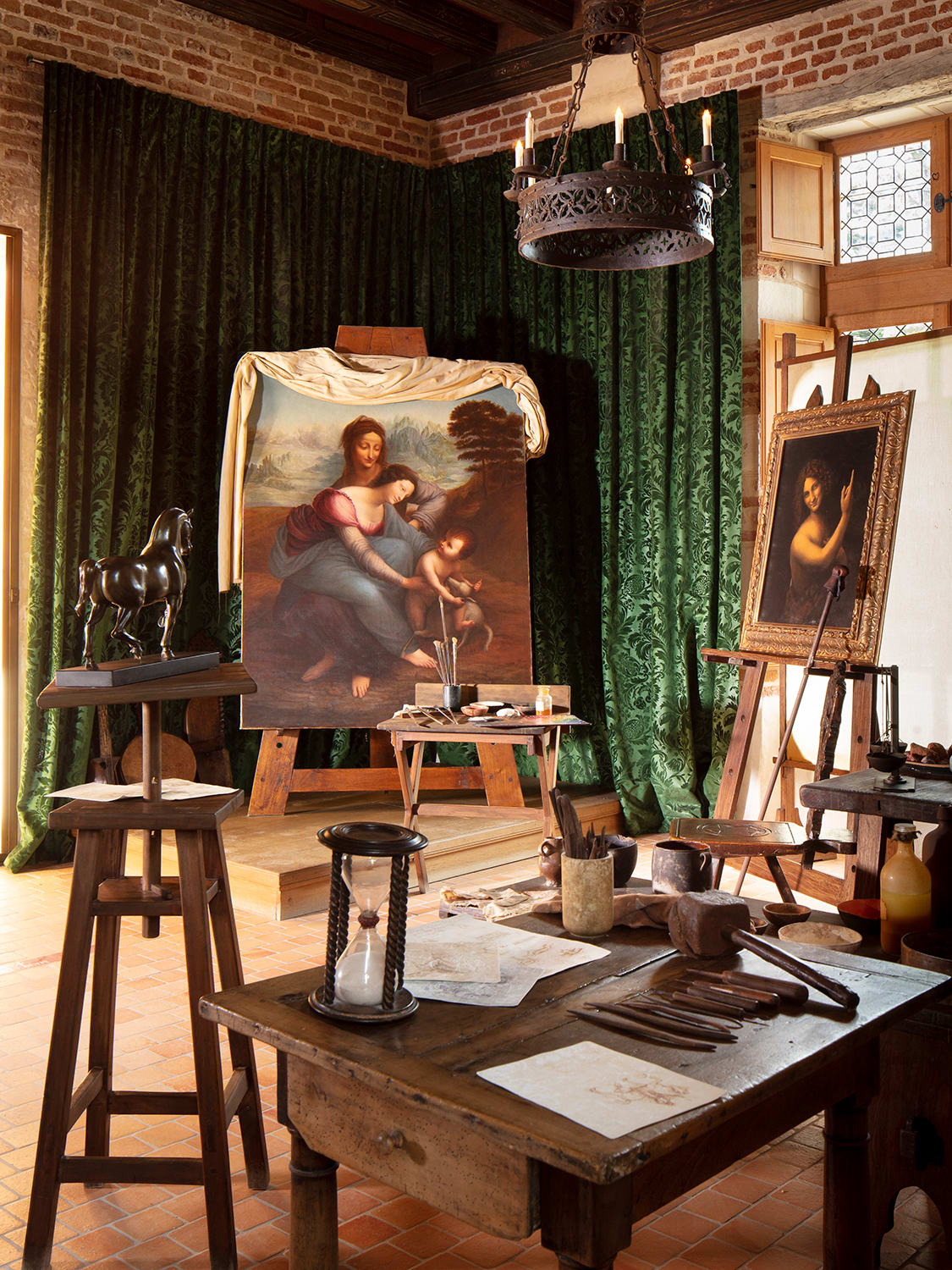
The building itself is not too big for younger ones to explore. A self-guided walk takes one through his bedchamber and workshop, while children can pick up an English Carnet de l’Inventeur (Inventer’s Notebook) to complete puzzles throughout the estate.
There’s a cafe in the manicured gardens with crepes and ice-cream, though a few snacks on hand never hurt. Everything can be covered in half a day, but it’s the kind of place worth lingering in if the weather is kind.
SAUMUR: A BALLET ON HORSEBACK
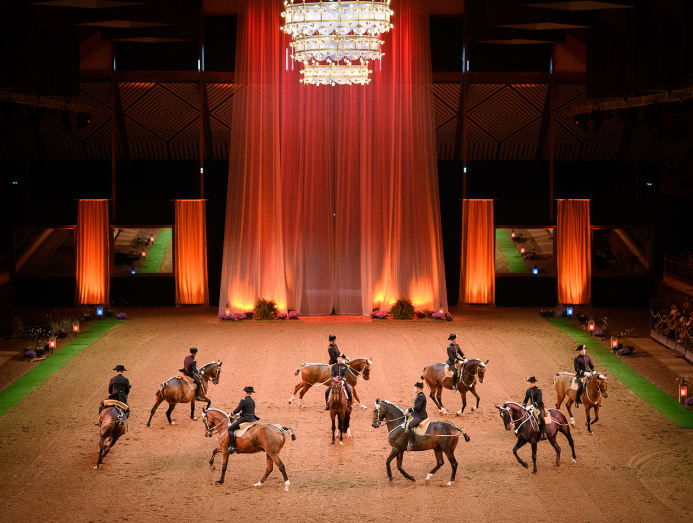
Saumur is home to Le Cadre Noir, France’s most prestigious riding school. Founded in the early 19th century, it still trains the country’s top equestrian riders in a style of horsemanship so graceful and precise that it’s often described as ballet on horseback.
For visitors, especially families, it’s a chance to watch the art of riding as it has been practised for generations by ecuyers (master riders). Picture powerful horses performing gravity-defying leaps and pirouettes with near invisible cues, all in perfect synchrony with their riders.

Morning Matinales, held on select weekdays from February through to October, offer a front-row view of training in progress ̶ from dressage to obstacle work ̶ with live French narration and English translation via a headset. Guided tours are also available, taking you through the stables, saddlery and historic halls. English tours can be arranged on request.
Often booked out well in advance, evening galas present the full spectacle, with uniformed or costumed riders performing choreographed routines, offering a truly theatrical display of equestrian artistry.
LOURESSE-ROCHEMENIER: THE ALLURE OF AN UNDERGROUND VILLAGE
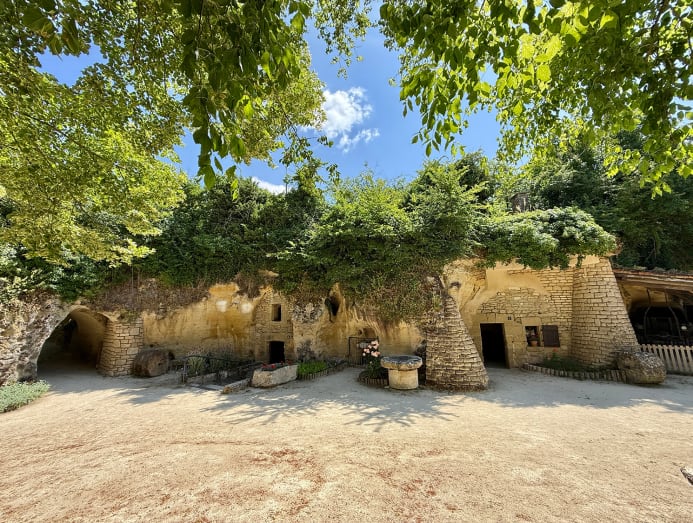
Louresse-Rochemenier is a quiet village with a secret underground. Here, one of the most complete troglodyte settlements in the Loire has been carved by hand into falun – a marine limestone made up of ancient shells and coral.
At the Musee Troglo de Rochemenier, what begins as a modest entrance soon gives way to a sprawling subterranean village: Two farms with living quarters, stables, courtyards, farming tools, even a 13th-century chapel. It’s a glimpse into a way of life that began in the Middle Ages and lasted right up until the 1930s, when the last residents moved above ground.
The sense of discovery is immediate, especially for children. My son, a fan of Percy Jackson, was eager to visit as ‘troglodytes’ appear in the series as mythical, cave-dwelling creatures known as Trogs. There were no reptilian humanoids, of course, but the space had its own kind of enchantment, prompting questions about life underground and the reasons people chose it.
PUY DU FOU: THE WILDEST SECRET IN FRANCE
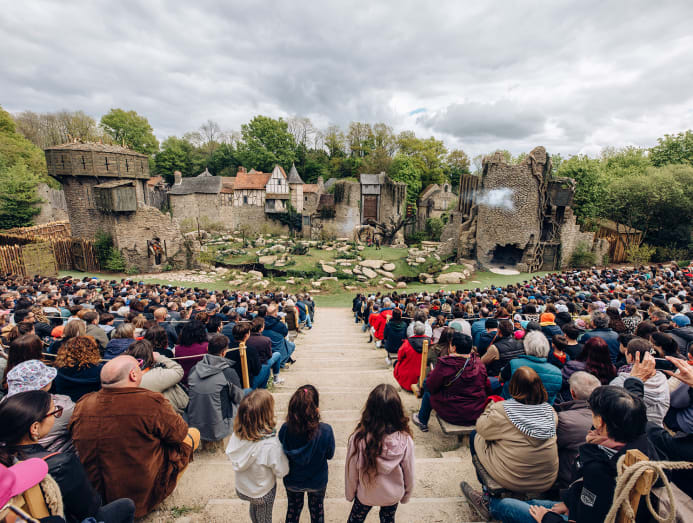
One of France’s best-kept theme park secrets, Puy du Fou is unlike anything else. There’s not a single roller coaster in sight. Instead, it stages immersive shows that sweep through different eras of history, each epic in scale and imagination.
In one arena, a Gallo-Roman coliseum, gladiators clash and chariots race in Le Signe du Triomphe. In another, Les Vikings stages a seaborne raid, complete with boats that rise from underwater.
Le Bal des Oiseaux Fantomes is one of the largest falconry shows in the world, where eagles, vultures, falcons descend in choreographed flight from a hot-air balloon suspended in the sky, skimming just above the audience in the finale. The park also runs a falconry academy, home to more than 1,000 birds, dedicated to both show and for conservation work.

The largest production, La Cinescenie, takes place after dark on what is officially the world’s biggest stage. With more than 3,000 performers, 30,000 costumes, and a breathtaking mix of fireworks, drones and water choreography, it traces the journey of a fictional family through centuries of war, revolution and change.
All shows are in French, but the Puy du Fou app offers live English audio translation and background synopses for each show. With headphones, even younger children can follow along, though the storytelling is so visual that language doesn’t get in the way.
You’ll want at least two full days as the park is vast. Puy du Fou has five themed hotels. We stayed on-site at La Villa Gallo-Romaine, styled like a Roman village. Others include Le Camp du drap d’Or, where Renaissance tents are dressed in regal detail, and La Citadelle, set within the stone walls of a medieval city.
Book early. If available, opt for the Pass Emotion which allows fast-track entry to key shows. La Cinescenie is ticketed separately and runs only on weekends from June to early September.
NANTES: WHERE THE MACHINES DREAM
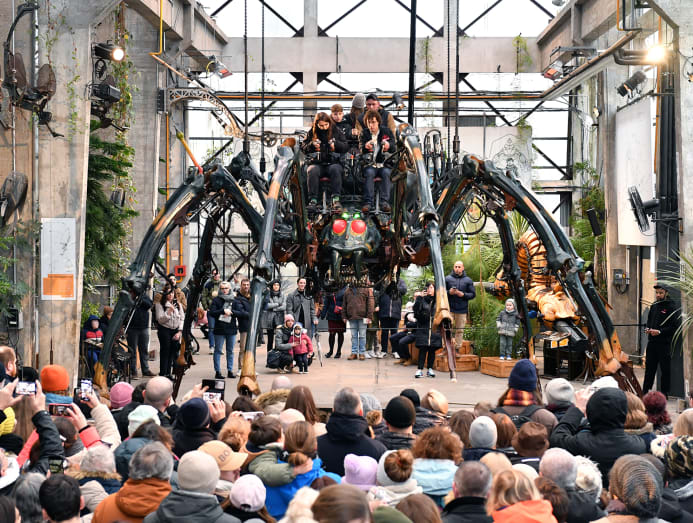
The little isle where Machines de l’lle lives in Nantes is one of those places you’ll never forget.
A towering 12m-tall elephant in steel and wood lumbers through its streets with visitors on its back, trunk spraying mist into the air and onto gleeful children. Le Grand Elephant is the star of the ambitious, ongoing project that blurs the line between engineering and art, drawing inspiration from Jules Verne and Leonardo da Vinci to bring monumental mechanical creatures to life. Behind it is Francois Delaroziere, the artistic director of La Machine, whose creations span the globe: From a fire-breathing dragon-horse in Beijing, to a towering Minotaur in Toulouse.
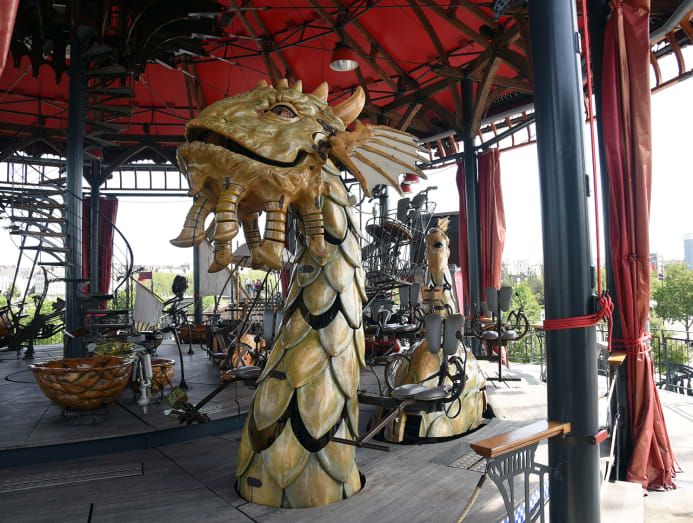
Nearby, find Le Carrousel Mondes Marins (The Carousel of the Sea World), which reimagines the ocean across three sculptural tiers: From the mysteries of the deep to surface storms and ships. Surreal creatures spin, crank and climb, making it more interactive artwork than amusement ride – with a tinge of Edward Scissorhands. Even adults will feel like they’ve stumbled into a spinning movie prop workshop.
There’s more to explore inside La Galerie des Machines, where engineer-guides present prototypes and creations in a laboratory, from a two-storey spider that emerges from the ground to a giant flying heron carrying people in baskets. Tours are in French, but the tour guides are multilingual and engaging, answering questions with warmth. It’s wildly photogenic, yes. Unlike most attractions, it doesn’t feel made for social media but by people who still build for wonder.
PORT-SAINT-PERE: A SAFARI DRIVE-THROUGH
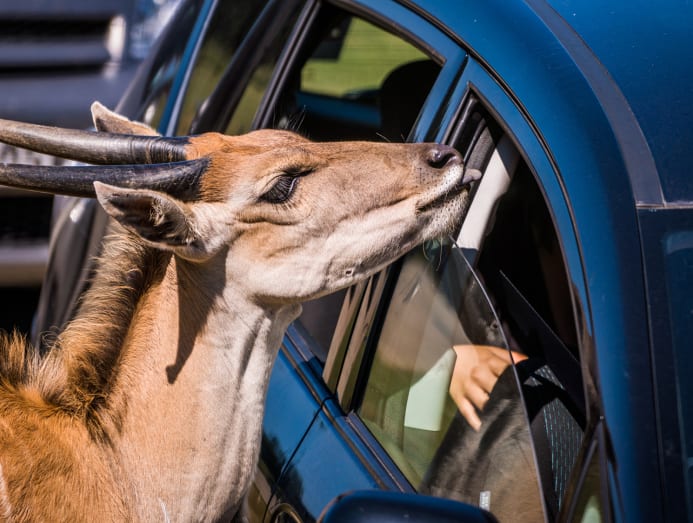
Planete Sauvage delivers a different kind of wildlife experience. It begins with a 10km safari loop where giraffes, rhinos and zebras roam free and may come right up to your car window. It can be explored in your own vehicle or hop into a 4×4 convoy with English commentary, inching along as the animals saunter past you. After the drive, the adventure continues on foot. Cross a suspension bridge that hangs above macaques, step into a replica Senufo village from West Africa and get up close to flamingos, lemurs and reptiles.
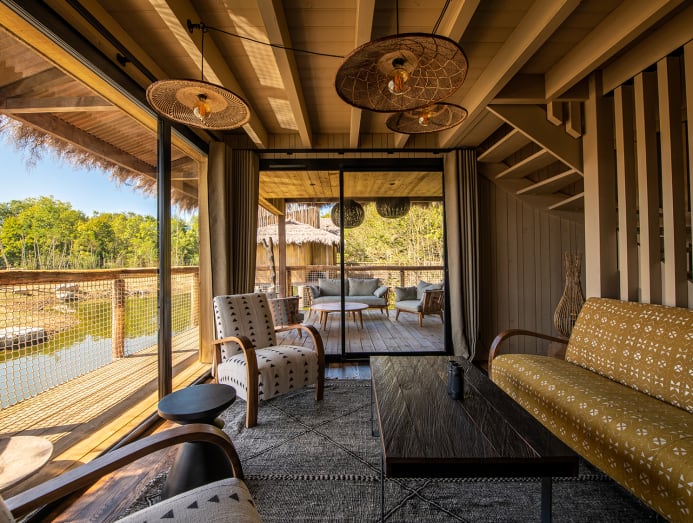
For families staying overnight, the Planete Safari Lodges offer comfortably styled suites right next to animal enclosures, with views of lions, tigers, cheetahs or giraffes, each one offering a different kind of thrill. Wake early and you might glimpse a keeper making rounds, or lock eyes with a lion over your first coffee. Not your usual morning routine, but that’s the charm.
MONT-SAINT-MICHEL: A MAGICAL DISAPPEARING ISLAND
Mont-Saint-Michel is one of France’s most visited landmarks, and for good reason ̶ it rises out of the water like a mythical city.
It transforms into a fortress island for a few hours each day ̶ at high tide when the sea engulfs it completely. At low tide, the bay empties out, revealing sand flats that can be crossed on foot with a local guide – an unforgettable way to arrive.
The climb through the village to the top is steep and uneven, and it winds past stone houses and souvenir shops. At the summit the Gothic abbey sits perched, once a pilgrimage site, later a prison. Inside, vast halls and high arches echo with centuries of history. It’s not suitable for strollers and smaller children may find the steps a challenge, but older ones with a sense of adventure will thrive here.
Near the entrance to the island is La Mere Poulard, an institution famous for delicious souffle-like omelettes whipped to airy volume and cooked over a wood fire. First served 130 years ago to travellers, the recipe remains unchanged today.
Mont-Saint-Michel is not a casual stop; it requires advance planning (arrive early or stay overnight), good walking shoes and luck with the weather but if you can make it to this UNESCO World Heritage Site, few places compare.
GIVERNY: MONET’S LENS

As the final stop before returning to Paris, Claude Monet’s home and gardens in Giverny offer a peaceful, poetic close to the journey.
The house is as vibrant as his Impressionist paintings: Green shutters, a yellow dining room, floral prints in every corner. But it’s the spell-binding gardens that leave the deepest impression. Outside the front door of the Clos Normand is a tumble of tulips, dahlias, roses and poppies arranged in painterly layers. Across the lane lies the Japanese water garden, where bamboo, weeping willows and the iconic lily pond appear just as they do in his work. Monet’s signature arched green bridge still stands, framed by blooms.

Inside, Monet’s former studio has been restored, with large-scale reproductions of his work and family portraits. Most signage is in French, but printed guides in English are available, and children’s activity booklets can be downloaded from the official website.
Giverny invites a gentler pace for children, especially those with a budding interest in art. Pack some art supplies to sketch from the benches and take in the same scenes that once inspired Monet.
TIPS FOR GETTING AROUND
Language
English is not widely spoken in the French countryside, but most attractions have English signage or audio guides. The locals are helpful but learning a few polite phrases in French will go a long way.
Food
Always plan ahead for meals. Restaurants may be closed on Sundays or Mondays; lunch service often ends by 2pm and most restaurants only open for dinner at 7pm. Supermarkets are usually closed on Sundays. Check the town’s local markets day as they might have Asian food vendors (few things are better than finding Pad Thai noodles in the French countryside). Booking stays with kitchenettes can be a lifesaver.
Driving and Logistics
Car seats for children are required by law. Many autoroutes (highways) are toll roads; bring cash or a credit card. Double-check fuel availability in rural areas, especially on Sundays. Most aires (rest stops) on highways are clean and family-friendly with food kiosks, restaurants and playgrounds.
Safety and Ease
Travelling outside major cities brings an unexpected sense of calm. It’s cleaner, quieter and often more beautiful. Children have more freedom to roam and for parents, the usual hyper-alertness melts away.
One final observation
You may notice something curious in restaurants and parks: Even the youngest French children sit patiently, sans screens. Whether it’s the pace of the countryside, the absence of overstimulation or something more deeply cultural, there’s a sense that everyone is invited to slow down. For families used to moving fast, it’s a welcome reset.










